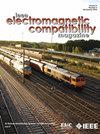集成电路中芯片背面易受有意电磁干扰影响的问题
IF 2
3区 计算机科学
Q3 ENGINEERING, ELECTRICAL & ELECTRONIC
IEEE Transactions on Electromagnetic Compatibility
Pub Date : 2024-08-28
DOI:10.1109/TEMC.2024.3440919
引用次数: 0
摘要
在倒装芯片组装过程中,集成电路(IC)的背面由于是开放表面,很容易受到有意的电磁干扰。在本文中,我们提出了一个模型,在这个模型中,来自芯片背面硅衬底局部区域的传导电流噪声会导致互补金属氧化物半导体(CMOS)数字电路出现误差。该模型首次解释了集成电路背面高压脉冲(HVP)注入导致双稳态电路位翻转错误的机理。从集成电路背面注入的电流不仅会流入配电网络,还会通过双阱结构 N 沟道晶体管(NMOS)中的体/漏极或体/源极 p-n 结二极管对下一阶段的栅极电容充电,从而导致位翻转错误。在这项研究中,使用集成电路芯片的三维 RC 网络模型和 HVP 注入器进行了电路仿真。模拟结果表明,P-阱电压偏置取决于分接单元的排列,从而在 D 型触发器的双稳态电路中再现了位翻转错误。仿真结果在制造的集成电路原型芯片上进行了验证,证实了与物理布局相关的误差的数据依赖趋势。本文章由计算机程序翻译,如有差异,请以英文原文为准。
Chip-Backside Vulnerability to Intentional Electromagnetic Interference in Integrated Circuits
The backside of integrated circuits (ICs) in flip-chip assembly is susceptible to intentional electromagnetic interference due to its open surface. In this article, we propose a model in which conducted current noise from a localized area of the Si substrate on the chip-backside causes errors in complementary metal-oxide-semiconductor (CMOS) digital circuits. This model explains for the first time the mechanism of bit-flip errors in bistable circuits caused by high-voltage pulse (HVP) injection on the backside of the IC. The injected current from the backside of the IC not only flows into the power distribution network, but also charges the gate capacitance of the next stage via p–n junction diodes of body/drain or body/source in N-channel
mosfet
s (NMOS) with twin-well structures, resulting in bit-flip errors. In this study, circuit simulations were performed using a three-dimensional
RC
network model of the IC chip and an HVP injector. These simulations have shown that the P-well voltage is biased depending on the arrangement of the tap cells, reproducing bit-flip errors in the bistable circuit of a D flip-flop. The simulation results were validated on a fabricated prototype IC chip, which confirmed the trend of data dependency for errors related to the physical layout.
求助全文
通过发布文献求助,成功后即可免费获取论文全文。
去求助
来源期刊
CiteScore
4.80
自引率
19.00%
发文量
235
审稿时长
2.3 months
期刊介绍:
IEEE Transactions on Electromagnetic Compatibility publishes original and significant contributions related to all disciplines of electromagnetic compatibility (EMC) and relevant methods to predict, assess and prevent electromagnetic interference (EMI) and increase device/product immunity. The scope of the publication includes, but is not limited to Electromagnetic Environments; Interference Control; EMC and EMI Modeling; High Power Electromagnetics; EMC Standards, Methods of EMC Measurements; Computational Electromagnetics and Signal and Power Integrity, as applied or directly related to Electromagnetic Compatibility problems; Transmission Lines; Electrostatic Discharge and Lightning Effects; EMC in Wireless and Optical Technologies; EMC in Printed Circuit Board and System Design.

 求助内容:
求助内容: 应助结果提醒方式:
应助结果提醒方式:


